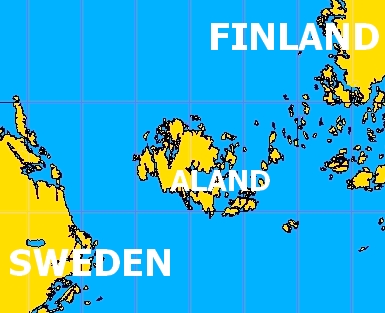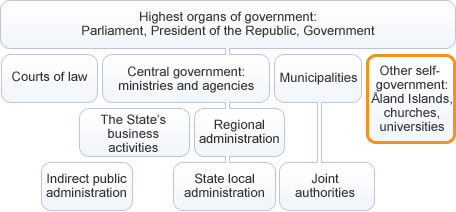Welcome to the Virtual Education Wiki ~ Open Education Wiki
Aland Islands
For the information relevant to Re.ViCa see Åland Islands.
The two pages will be consolidated during September 2011.
By Merja Sjöblom, Finnish Information Society Development Centre
Partners situated in Åland Islands
none, see Finland for Visced
Åland Islands in a nutshell
Mainly sourced from http://www.aland.ax/alandinbrief/index.pbs and Wikipedia

The Åland Islands are in the Baltic Sea, situated at the entrance to the Gulf of Bothnia. Åland Islands forms an autonomous, demilitarized, Swedish-speaking region and historical province of Finland. The capital is Mariehamn. The population of Åland Islands is about 28 000 people. The Åland Islands are governed according to the Act on the Autonomy of Åland and international treaties. These laws guarantee the islands’ autonomy from Finland, which has ultimate sovereignty over them, as well as a demilitarized status.
Åland comprises Fasta Åland (the "Main Island," with 90% of the population) together with an archipelago to the east that comprises over 6,500 skerries and islands. Fasta Åland is separated from the coast of Sweden by 38 kilometers of open water to the west. In the east, the Åland archipelago is contiguous with the Finnish Archipelago Sea. Åland's only land border is located on the uninhabited skerry of Märket which it shares with Sweden.
Read more on Åland Islands from a pdf document Åland in brief
The Provincial Autonomy of the Åland Islands
Diagram of the public administration from Suomi.fi
Education in Åland Islands
(mainly sourced from: Norden)
The Finnish Education system and policies are used also in Åland Islands. The education system consists of preschool and basic education, upper secondary and vocational schools as well as polytechnics and universities. The Finnish Education system from the VISCED point of view is described in Finland for Visced.
All education in Åland Islands is offered in Swedish.
Below are listed educational organizations in Åland Islands. Each organization contains a link to its website (in Swedish only):
Upper secondary and vocational schools
- Ålands folkhögskola
- Ålands lyceum
- Ålands handelsläroverk
- Ålands hotell- och restaurangskola
- Ålands sjömansskola
- Ålands vårdinstitut
- Ålands yrkesskola
Higher education
Other education
- Öppna högskolan på Åland
- Medborgarinstitutet (Medis)
- Ålands musikinstitut
- Bel Canto r.f.
- Ålands läroavtalscenter
Relevant websites
- Statistics Åland
- http://www.government.ax/
- Official co-operation in the Nordic region
- Ministry of Education and Culture in Åland
- Finland for Visced
The Åland Islands (Finnish: Ahvenanmaa) form an archipelago in the Baltic Sea. This is situated at the entrance to the Gulf of Bothnia
The archipelago forms an autonomous, demilitarized, monolingually Swedish-speaking administrative province, region and historical province of Finland.
The population is some 27,000.
The capital is Mariehamn.
The archipelago is the smallest province of Finland, comprising 0.5% of Finland's population and 0.49% of land area.
The islands consist of the main island Fasta Åland (literally "Firm Åland"), where 90% of the population resides, and an archipelago to the east that consists of over 6,500 skerries and islands. Fasta Åland is separated from the coast of Sweden by 40 kilometres (25 miles) of open water to the west. In the east, the Åland archipelago is virtually contiguous with the Finnish Archipelago Sea. Åland's only land border is located on the uninhabited skerry of Märket, which it shares with Sweden.
Due to Åland's autonomous status, the powers exercised at the provincial level by representatives of the central state administration in the rest of Finland are largely exercised by the Government of Åland in Åland
Relations with EU
The autonomous status of the islands was affirmed by a decision made by the League of Nations in 1921 following the Åland crisis. It was reaffirmed within the treaty admitting Finland to the European Union. By law, Åland is politically neutral and entirely demilitarised, and residents are exempt from conscription to the Finnish Defence Forces. The islands were granted extensive autonomy by the Parliament of Finland in the Act on the Autonomy of Åland of 1920, which was later replaced by new legislation by the same name in 1951 and 1991.
In connection with Finland's admission to the European Union, a protocol was signed concerning the Åland Islands that stipulates, among other things, that provisions of the European Community Treaty shall not force a change of the existing restrictions for foreigners (i.e., persons who do not enjoy "home region rights" (hembygdsrätt) in Åland) to acquire and hold real property or to provide certain services, implying a recognition of a separate nationality.
Most inhabitants have Swedish (the sole official language) as their first language: 91.2% in 2007, and 5.0% speak Finnish.
Schools
The language of instruction in publicly financed schools is Swedish, but an Ålandic municipality is free to provide teaching of Finnish. (In the rest of Finland, bilingual municipalities provide schooling both in Finnish and in Swedish.)
